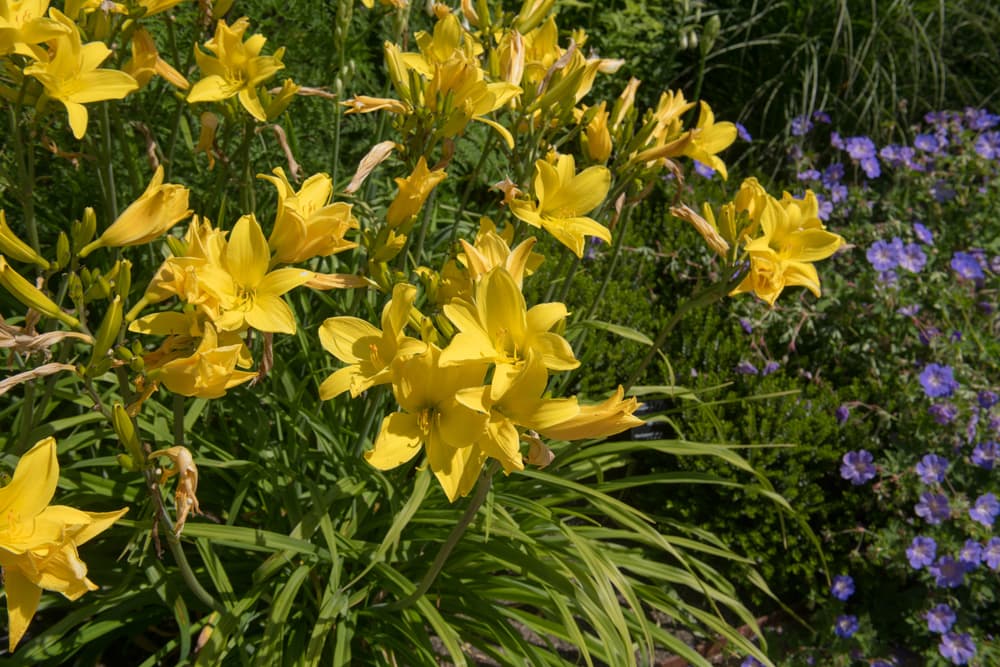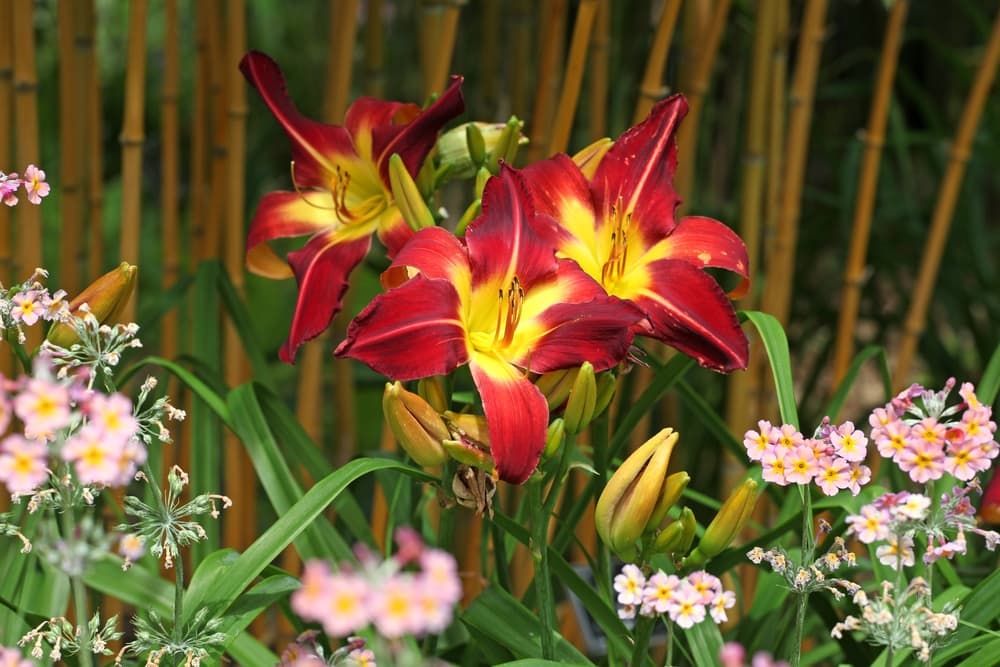PERENNIALS > HEMEROCALLIS
Chris is a gardening writer and nature enthusiast. He graduated from Oxford Brookes University in 2022 with an MA in Psychology. Chris works with the Leeds Green Action Society, helping their food cooperative by growing various fruit and vegetables on their two allotments in Hyde Park, Leeds.
Reviewed By COLIN SKELLY

Colin is a Horticulturist and Horticultural Consultant with experience in a range of practical and managerial roles across heritage, commercial and public horticulture. He holds the Royal Horticultural Society’s Master of Horticulture award and has a particular interest in horticultural ecology and naturalistic planting for habitat and climate resilience.
Contributions From STEVE AMY , PAULA DYASON

Paula is the Co-Owner of the specialist plant nursery Strictly Daylilies and the International Chair of the American Daylily Society. With a lifelong passion for hemerocallis, Paula is one of the top growers and hybridisers of daylilies in the UK. Paula also sits on the RHS committee for hemerocallis and helps to evaluate potential Award of Garden Merit candidates.
IN THIS GUIDE
HEMEROCALLIS GUIDES
This plant has a fantastic reputation thanks to its attractive and colourful flowers, tolerance of drought and heat stress, and the general ease of looking after it.
You’ll also hear this plant called ‘Daylily’, alluding to its flowers that appear one morning and quickly shrivel away, only to be replaced shortly after by another equally vibrant flower.
For this guide, we interviewed Steve Amy, Membership Chair at The American Daylily Society and Paula Dyason, Co-Owner of the specialist plant nursery Strictly Daylilies.
“Daylilies are very hardy in most climates and require very little care. If they receive 4-6 hours of sunlight daily and occasional watering, preferably by rainfall, they will thrive.
“For the most part, they are disease free and seldom invaded by destructive insects”, Steve says.

Gardeners growing Hemerocallis can expect yellows, oranges, golds, purples, and all manner of other bright and beautiful colours.
This ever-evolving symphony of flowers and colour appeals to seasoned and novice gardeners alike.
Overview
| Botanical Name | Hemerocallis |
| Common Name(s) | Daylilies |
| Plant Type | Perennial Flower |
| Native Area | East Asia |
| Hardiness Rating | H6 |
| Foliage | Some evergreen, some deciduous |
| Flowers | Large and dramatic flowers in many different bright shades |
| When To Sow | March, September |
| Flowering Months | June, July |
| When To Prune | June, July |
Sunlight
Preferred
Full Sun
Exposure
Exposed or Sheltered
Size
Height
0.1 – 0.5M
Spread
0.1 – 0.5M
Bloom Time
Mid-Summer
Soil
Preferred
Most Soil Types
Moisture
Moist but well drained
pH
Any
A perennial plant that flowers between late May and early August, bringing vibrant splashes of warm colour to any garden.
Hardy growth makes this a non-fussy plant well-suited to gardeners of all abilities.
“To me, hemerocallis cultivars are the ideal perennial, as they are easy to establish without being invasive,” says Paula.
“The abundant diversity of the daylily is clear to see in the plant’s colour, size and height.”
The clump-forming properties of many Hemerocallis cultivars make it well-suited to garden borders and beds, but you’re not limited to growing it in these locations.
Hemerocallis Cultivars
“With nearly 100,000 registered cultivars available worldwide there’s a lot to select from”, Steve explains when pressed about his favourite varieties to grow.
“Our garden is a registered ADS Display Garden which requires certain conditions of having a minimum count of different cultivars and different forms and varieties in order to qualify.”
“We don’t have a particular [favourite] type; dormant, evergreen, semi-evergreen (which refers to the type of foliage and how it performs in the autumn/winter months).
“All of these grow well for us in our zone. There are also several bloom forms and we don’t have a specific preference for those either.
“We like nearly all forms and colours.”

“Single, double, spider, polymerous, and sculpted are the official forms and I love them all,” adds Paula.
“There are also a huge array of bloom sizes, from 1-16 inches, whilst the scape heights can be as short as 5 inches but some can reach to 80 inches.
“With so many to choose from, there is indeed a daylily for every garden, every taste and every area of the United Kingdom!”
Despite such a wide range of cultivars, we’ve attempted to shortlist just some of the varieties that have received the RHS Award of Garden Merit.1Ornamental AGM Plants. (2021, July). Royal Horticultural Society. Retrieved March 16, 2023, from https://www.rhs.org.uk/plants/pdfs/agm-lists/agm-ornamentals.pdf
This commendation is given to plants that do particularly well in British gardens, making them an excellent place to start.
‘Ruby Spider’

The “trumpet-shaped, yellow-throated” flowers boasted by ‘Ruby Spider’ are indicative of what you can expect from Hemerocallis: a summer of colour and confidence, tumbling out of countless flowers.
You have to see the colour profile of this flower to believe it.
Eponymous ruby fades gradually into a dazzling yellow, with broad, flat petals making it impossible to resist.
‘Serena Sunburst’

Proud, buoyant yellow give sunburst its name. Looking at this flower, the comparison makes sense.
During warm weather, you’ll find a light peachy pink border, lending a bit more depth and elegance to the petals.
The shape is different from the ‘Ruby Spider’, with a narrower and slightly more rounded profile.
‘Serena Sunburst’ makes a fine addition to borders, beds, and beyond.
‘Burning Daylight’

From sunburst to ‘Burning Daylight’, Hemerocallis is definitely the plant to choose if you want the same range of colours in your garden as those created by the sun in the sky.
This cultivar plays mainly with orange, with broad, inviting flowers. It works well by itself or arranged with other types of daylily.
‘Pink Damask’

Sharing its name with a famous upholstery pattern, ‘Pink Damask’ effortlessly evokes the same refined sophistication as suites that use the fabric.
The clue is in the name with this cultivar. Prepare yourself for a regal pink blossom, drawing on multiple colours from the palette without ever looking gaudy.
This cultivar will work well in similar settings to other Hemerocallis.
‘Stafford’

The ‘Stafford’ is a quintessential example of the appeal of Hemerocallis.
This daylily combines red, orange, and yellow in a way that will melt the heart of even the most disinterested gardener.
A great way to liven up any area of your garden.
‘Venusian Heat’

Elegant red and yellow.
This daylily cultivar doesn’t bring anything too radically novel to the table, but it is another fantastic demonstration of why we love this plant.
This cultivar will work well standalone, or alongside others.
Planting Hemerocallis
When planting a Hemerocallis, you can expect it to grow up to a metre in height, with a spread of 10cm to a metre.
Most cultivars will grow to a maximum spread somewhere around 50cm, over two to five years.
This is a hardy plant, and it’s hard to go too far wrong when cultivating one.

Pretty much all cultivars have a hardiness rating of H6; they will stay healthy and strong in the UK in temperatures as low as -15°C.
Soil Requirements
This is a flexible, versatile plant that isn’t fussy when it comes to growing conditions.
In fact, it can grow well in some poorer-quality soils that other plants may struggle with.
“Although daylilies are extremely carefree, they will be most beautiful with adequate moisture and appropriate nutrients,” Paula explains.
All cultivars above will do best in clay, loam, or chalk. Certain cultivars can tolerate sand, too: ‘Ruby Spider’, ‘Serena Sunburst’, ‘Tuxedo Junction’, and ‘Sir Modred’.
All require moist but well-drained soil and can tolerate acid, alkaline, or neutral pH levels.
“A problem I [often] see with people growing daylilies is over-fertilising,” warns Paula.
“If growing in soil directly in the ground, it is always advisable to have a soil test prior to adding fertiliser, then treat as suggested.”
Where To Plant
Your Hemerocallis will need full sunlight to grow its best, so make sure to plant it somewhere south or west-facing.
“Hemerocallis is a great choice for a full sun spot,” shares Horticultural Consultant Colin Skelly.
“I’ve used them in a range of soils and they invariably both spread densely and flower profusely to provide an almost maintenance-free garden plant.”

Growing your plant in light shade won’t kill it, but the flowering will be less vibrant and plentiful – avoid planting in full shade.
If possible, plant somewhere that will get five or six hours of sunlight per day.
When growing darker-coloured varieties, you may want to bear in mind that shade in the afternoon will lead to better colour retention.
When To Plant
For best results, plant your daylily in spring or autumn.
This means ideally in April, or in the few weeks between late September and the end of October.
Planting Out
You can buy daylily plants from seed, or pre-grown in packets – if choosing the latter, be aware they will need more attention early on.
You shouldn’t plant them out directly. Instead, pot them in compost, keep it moist, and keep somewhere cool until they’re growing well.
Plant out your tended daylily in the spring or autumn, as per the previous section.

Growing from seed is easy: just plop them in holes around 2cm deep, and keep well-watered until seedlings appear – this should take about a fortnight.
Be aware that growing from seed means you’ll have to wait longer for flowers. Expect this to take anywhere up to three years.
Daylily Care
Improving the soil with general-purpose fertiliser is a good way to boost lacklustre growth.
Mulch – compost or manure – will keep in soil moisture if your plant is struggling to get enough.
Propagation
Daylilies are ripe for propagation.
Their ability to cross-pollinate relatively easily compared to other flowers means that you can create your own hybrids.
To give this a go, you’ll have to manually pollinate a female plant with the pollen of a male one.
There’s a chance a seed pod will develop, and if it does, you can plant the seeds as instructed in the previous section.

After a couple of years, you’ll be able to see whether your matchmaking worked!
Pruning
Compared to other plants, Hemerocallis needs very little in the way of pruning.
It’s only advised out of necessity when you are in an area prone to gall midge (more on this later).
Otherwise, pruning is purely an aesthetic consideration.
Common Problems
There are a few pests that like to make their home on Hemerocallis plants.
“Deer, rabbits and other vegetation-eating animals will eat the foliage, blooms and buds.
“The insects will damage the blooms and foliage which will not kill the plant but rob you of the beauty”, Steve Amy shares.
“Animal repellents are effective in keeping them away and are not always toxic to the plant.
“Insect repellents or killers also work, but they can harm plants and are only to be used when an infestation is severe”.
When you welcome this flower into your garden, it’s a good idea to familiarise yourself with the risks and their symptoms.
This way you can nip any issues in the bud (if you’ll excuse the pun).
Aphids
Although they’re small, these pests can wreak massive amounts of havoc on your daylilies.
If you get an infestation, you’ll find large colonies of tiny bugs living on the underside of your plant’s leaves.
To satisfy their voracious appetites, aphids feast on sap.
Once this is drained, Hemerocallis begins to wilt and lose its usual enthusiasm.
Not only that, but a byproduct of their presence can attract other pests.

Your best course of action is to spray plants with water and insecticidal soap.
This should dislodge small infestations, but for bigger ones you may have to turn to pesticides.
Vigilance is a good policy: you can usually spot and remove aphid populations before they overcome your plant.
Slugs & Snails
You’ll find that Hemerocallis is not exempt from these slimy visitors, the bane of every gardener’s life.
Slug and snail remedies vary, with each gardener citing their own secret technique.
Some people leave small troughs of beer to attract these pests away from their flowers.
Others use ammonia solution to discourage them, and still-crueller gardeners use perimeters of salt to dissolve them before they can reach their intended dinner.
We wish you luck, whatever solution you decide to use.
Glasshouse Red Spider Mite
Here is another hungry pest that can cause surprising amounts of damage to your Hemerocallis plant.
The red spider mite will suck sap from your plants, gradually depleting them until, if left uninterrupted, they risk an untimely demise.

The mites prefer warm weather, so keep a careful eye out in the summer.
You’ll see mottled leaves, fine webbing on plants, and weaker-looking petals.
Because of their tendency to be in warm places, you’ll be less at risk with plants outdoors than in greenhouses, but we still recommend keeping your eye out.
Thrips
These bugs, also sometimes called thunder flies, suck sap from flowers for sustenance.
Leaves they’ve feasted upon grow dull and discoloured.
They’ll also leave waste-products after feeding, in the form of little black spots.
Pesticides are recommended for removing thrips – you’ll need to use a few applications to kill bugs and larvae that hatch from any already-planted eggs.
Hemerocallis Gall Midge
“The worst problem we have in the UK is the presence of Hemerocallis gall midges,” says Paula.
If your Hemerocallis has swollen buds that don’t open, you may have been visited by gall midges.
These flies lay their eggs on young Hemerocallis flower buds, and the hatched larvae play havoc with the buds’ development.

“You can control them by picking off the affected buds, which will be distorted and swollen,” advises Paula.
“The buds need to be frozen in bags for several days or burned. Make sure they are dead and do not place on your compost heap or in the green bin.”
The RHS advises asking your neighbours to do the same so that the spread can be reduced.
Late-flowering Hemerocallis plants are less prone to gall midge because their laying season ends before flowering begins, as Paula shares:
“There is no treatment to date for this, but it can generally be avoided by growing varieties that bloom later in the season, as they usually only affect early and early mid-season varieties.”
If you’re especially worried about this pest, maybe consider one of the varieties that flowers later: ‘Pink Damask’, ‘Stafford’, ‘Burning Daylight’, and ‘Red Precious’.
Hemerocallis, daylily, or whatever you decide to call them, we’re sure this flower will make a fantastic contribution to your garden.
They are easy to grow and look after, and draw on an astounding colour palette – from gentle pinks through to rich, hearty reds.
References
- 1Ornamental AGM Plants. (2021, July). Royal Horticultural Society. Retrieved March 16, 2023, from https://www.rhs.org.uk/plants/pdfs/agm-lists/agm-ornamentals.pdf


